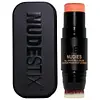What's inside
What's inside
 Key Ingredients
Key Ingredients

 Benefits
Benefits

 Concerns
Concerns

 Ingredients Side-by-side
Ingredients Side-by-side

Octyldodecanol
EmollientHydrogenated Polyisobutene
EmollientHydrogenated Poly(C6-14 Olefin)
EmollientPolyethylene
AbrasiveSilica
AbrasiveDiisostearyl Malate
EmollientSynthetic Wax
AbrasiveSynthetic Fluorphlogopite
Sorbitan Isostearate
EmulsifyingEthylene/Propylene Copolymer
AbrasiveCera Microcristallina
Emulsion StabilisingTocopherol
AntioxidantMethicone
EmollientTriethoxycaprylylsilane
BHT
AntioxidantCI 77891
Cosmetic ColorantCI 77492
Cosmetic ColorantCI 15850
Cosmetic ColorantCI 19140
Cosmetic ColorantOctyldodecanol, Hydrogenated Polyisobutene, Hydrogenated Poly(C6-14 Olefin), Polyethylene, Silica, Diisostearyl Malate, Synthetic Wax, Synthetic Fluorphlogopite, Sorbitan Isostearate, Ethylene/Propylene Copolymer, Cera Microcristallina, Tocopherol, Methicone, Triethoxycaprylylsilane, BHT, CI 77891, CI 77492, CI 15850, CI 19140
Diisostearyl Malate
EmollientDimethicone
EmollientPolybutene
Caprylyl Methicone
Skin ConditioningVinyl Dimethicone/Methicone Silsesquioxane Crosspolymer
Synthetic Wax
AbrasiveBis-Diglyceryl Polyacyladipate-2
EmollientPolyethylene
AbrasiveDimethicone/Vinyl Dimethicone Crosspolymer
Skin ConditioningKaolin
AbrasiveAluminum Starch Octenylsuccinate
AbsorbentC12-15 Alkyl Benzoate
AntimicrobialTocopheryl Acetate
AntioxidantSilica
AbrasiveCaprylyl Glycol
EmollientPentaerythrityl Tetra-Di-T-Butyl Hydroxyhydrocinnamate
AntioxidantHexylene Glycol
EmulsifyingPhenoxyethanol
PreservativeCI 77891
Cosmetic ColorantIron Oxides
CI 15850
Cosmetic ColorantDiisostearyl Malate, Dimethicone, Polybutene, Caprylyl Methicone, Vinyl Dimethicone/Methicone Silsesquioxane Crosspolymer, Synthetic Wax, Bis-Diglyceryl Polyacyladipate-2, Polyethylene, Dimethicone/Vinyl Dimethicone Crosspolymer, Kaolin, Aluminum Starch Octenylsuccinate, C12-15 Alkyl Benzoate, Tocopheryl Acetate, Silica, Caprylyl Glycol, Pentaerythrityl Tetra-Di-T-Butyl Hydroxyhydrocinnamate, Hexylene Glycol, Phenoxyethanol, CI 77891, Iron Oxides, CI 15850
 Reviews
Reviews

Ingredients Explained
These ingredients are found in both products.
Ingredients higher up in an ingredient list are typically present in a larger amount.
Ci 15850 is the pigment color red. It is an azo dye and created synthetically.
Azo dyes need to be thoroughly purified before use. This allows them to be more stable and longer-lasting.
This ingredient is common in foundations, lipsticks, and blushes. This color is described as brown/orangey red.
It has many secondary names such as Red 6 and Red 7. According to a manufacturer, Red 6 usually contains aluminum.
Learn more about CI 15850Ci 77891 is a white pigment from Titanium dioxide. It is naturally found in minerals such as rutile and ilmenite.
It's main function is to add a white color to cosmetics. It can also be mixed with other colors to create different shades.
Ci 77891 is commonly found in sunscreens due to its ability to block UV rays.
Learn more about CI 77891Diisostearyl Malate is an emollient and most often used in lip products. It comes from isostearyl alcohol, a fatty acid, and malic acid, an AHA.
As an emollient, Diisostearyl Malate helps create a thin film on your skin to trap moisture in. This helps keep your skin soft and smooth.
Polyethylene is a synthetic ingredient that helps the skin retain moisture. It is a polymer.
It is also typically used within product formulations to help bind solid ingredients together and thicken oil-based ingredients. When added to balms and emulsions, it helps increase the melting point temperature.
Silica, also known as silicon dioxide, is a naturally occurring mineral. It is used as a fine, spherical, and porous powder in cosmetics.
Though it has exfoliant properties, the function of silica varies depending on the product.
The unique structure of silica enhances the spreadability and adds smoothness, making it a great texture enhancer.
It is also used as an active carrier, emulsifier, and mattifier due to its ability to absorb excess oil.
In some products, tiny microneedles called spicules are made from silica or hydrolyzed sponge. When you rub them in, they lightly polish away dead skin layers and enhance the penetration of active ingredients.
Learn more about SilicaSynthetic Wax is created from fossil fuels such as natural gas. It is used to enhance texture, adjust pH, and as an occlusive.
It may also be used as an abrasive ingredient to exfoliate the skin.
Synthetic Wax may not be fungal acne safe.
Learn more about Synthetic Wax